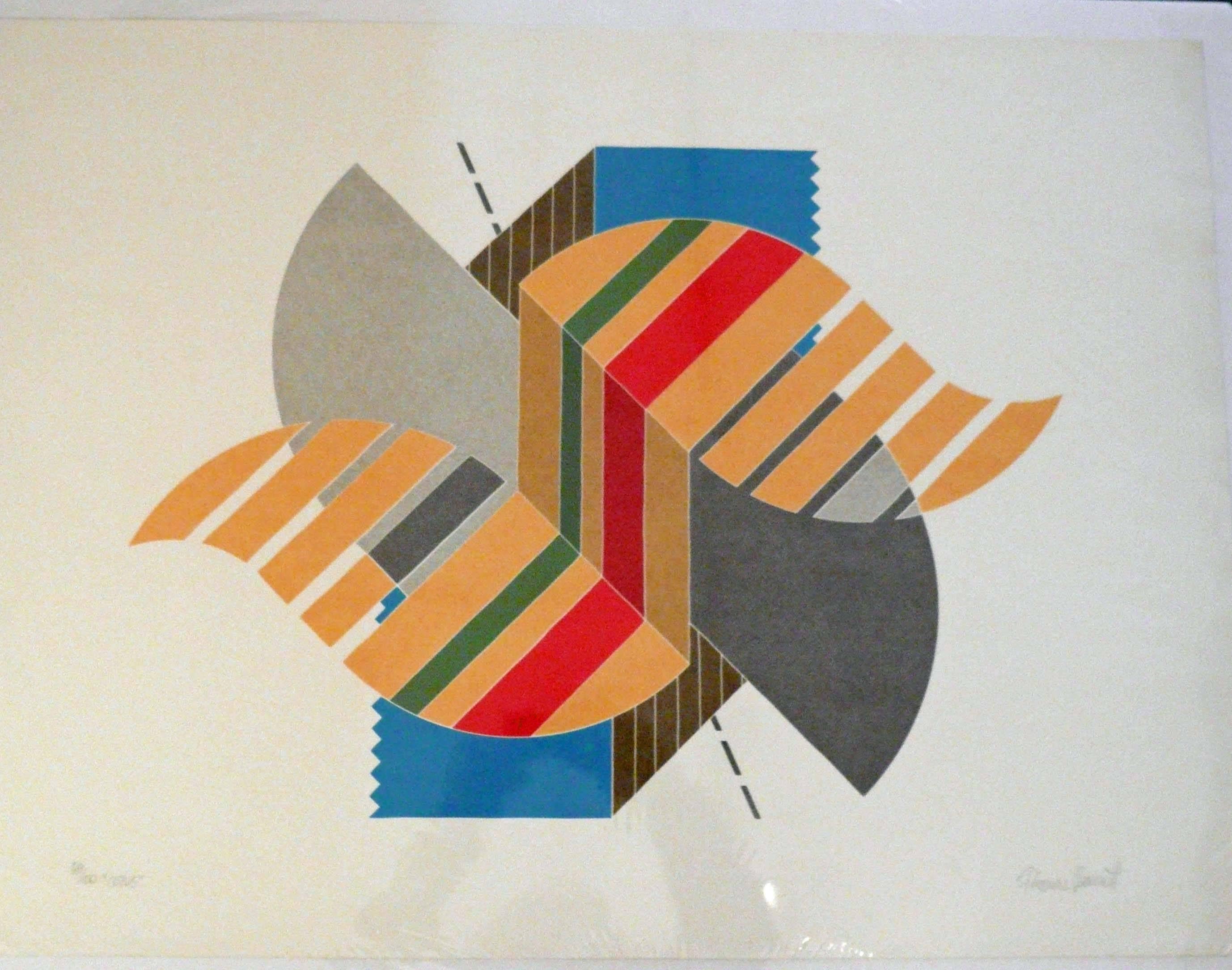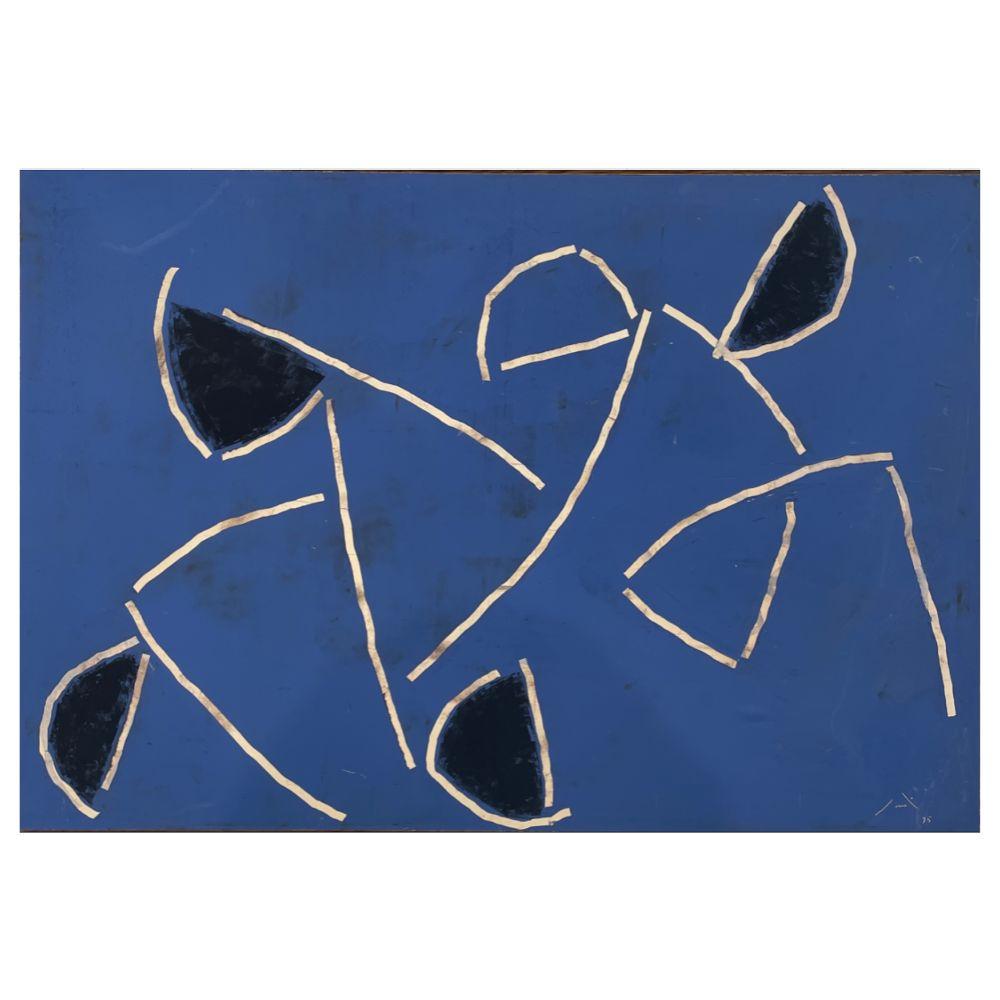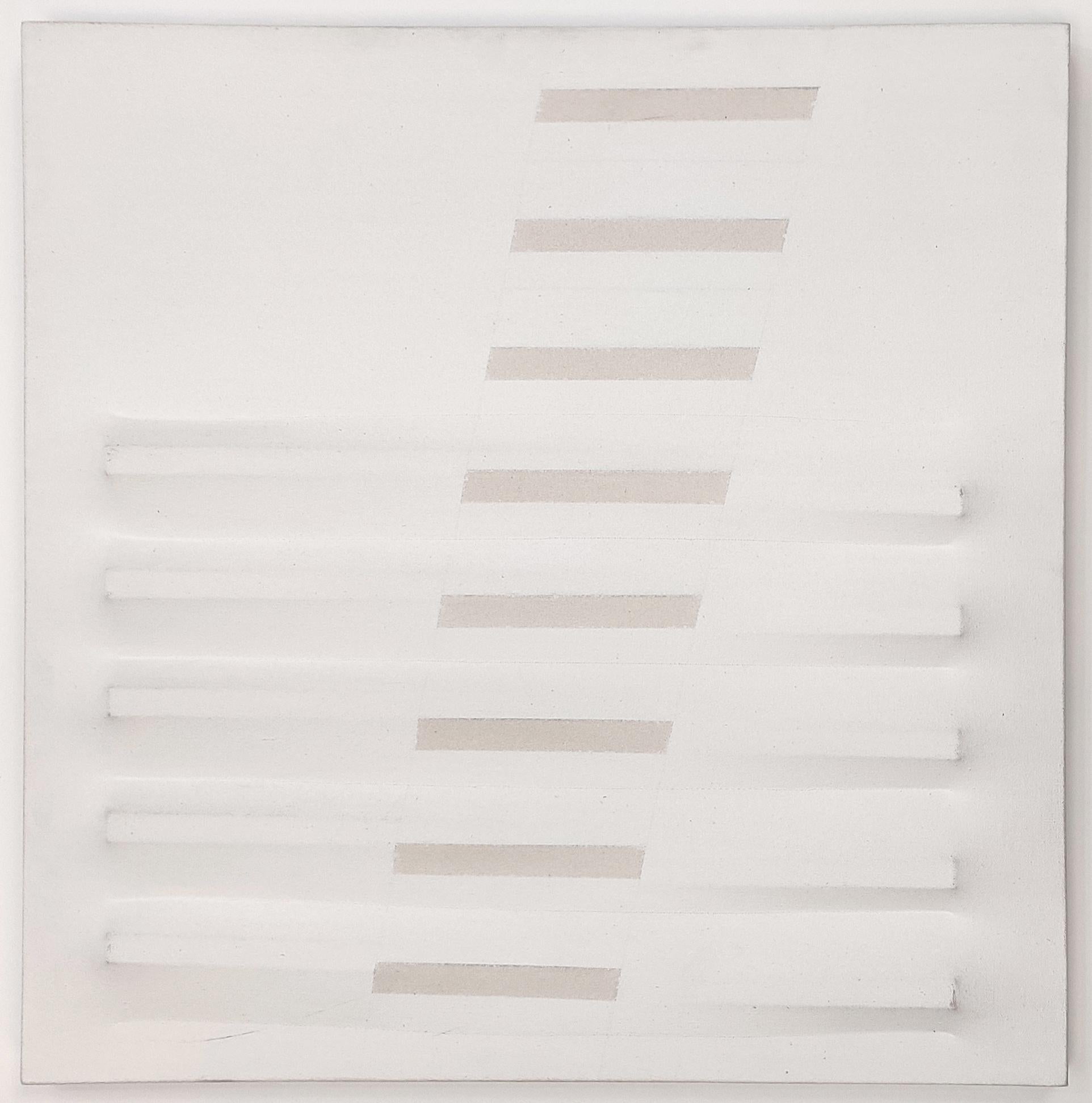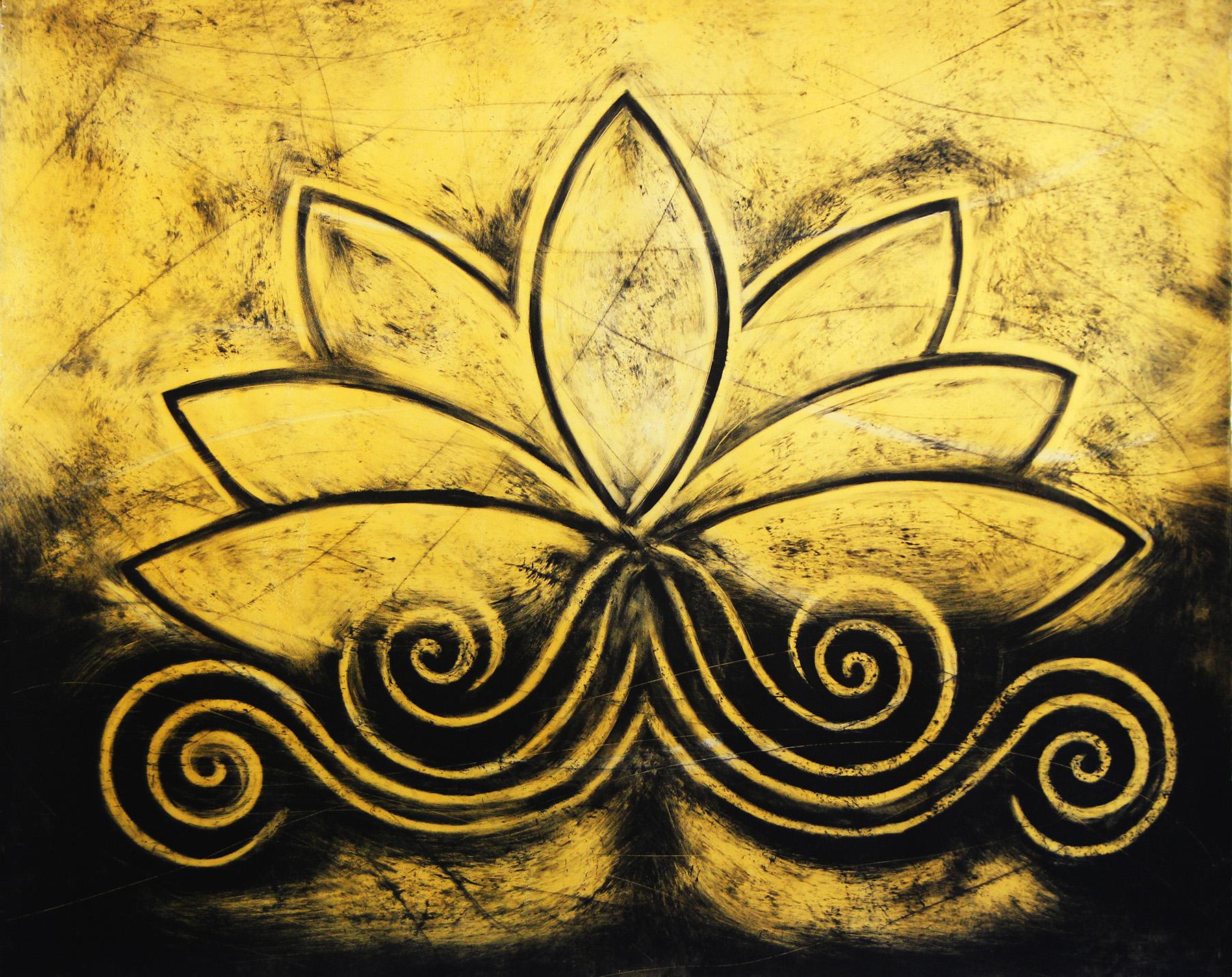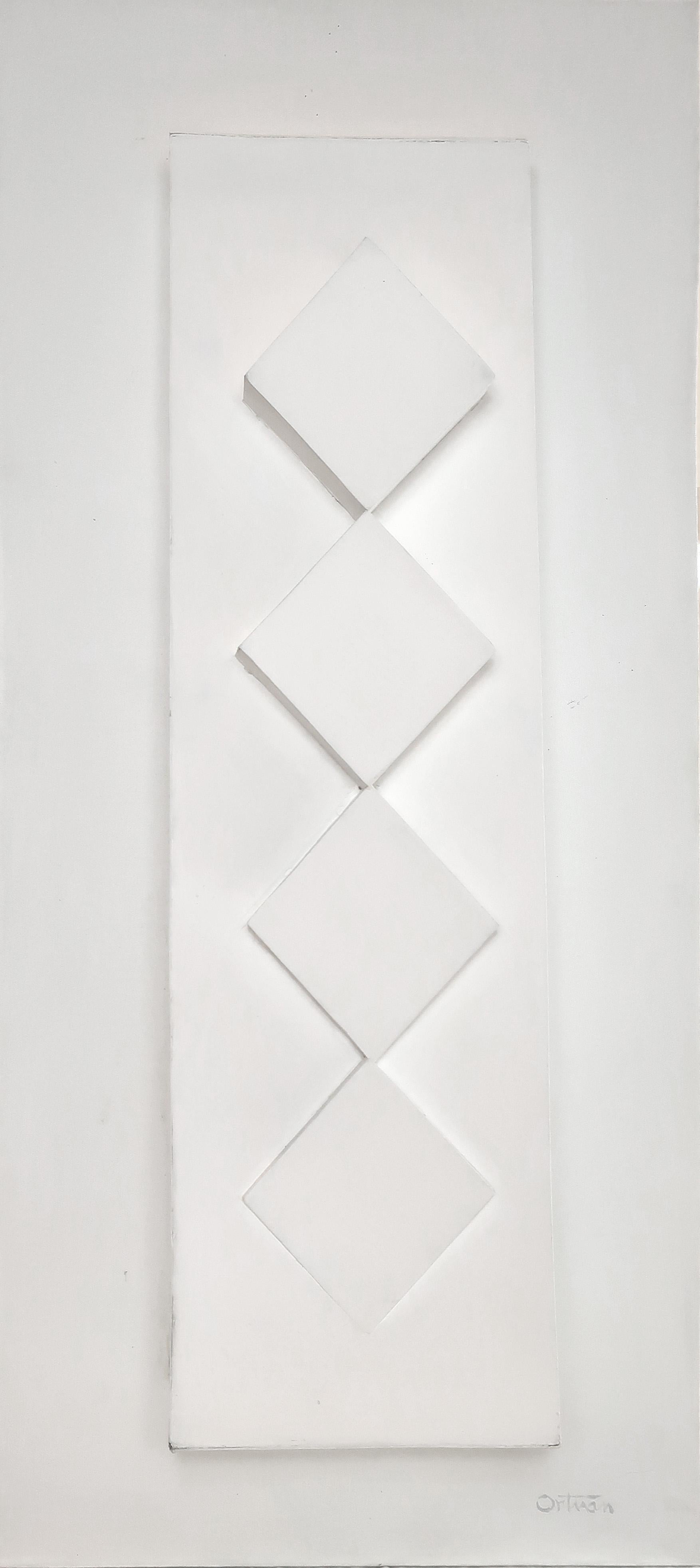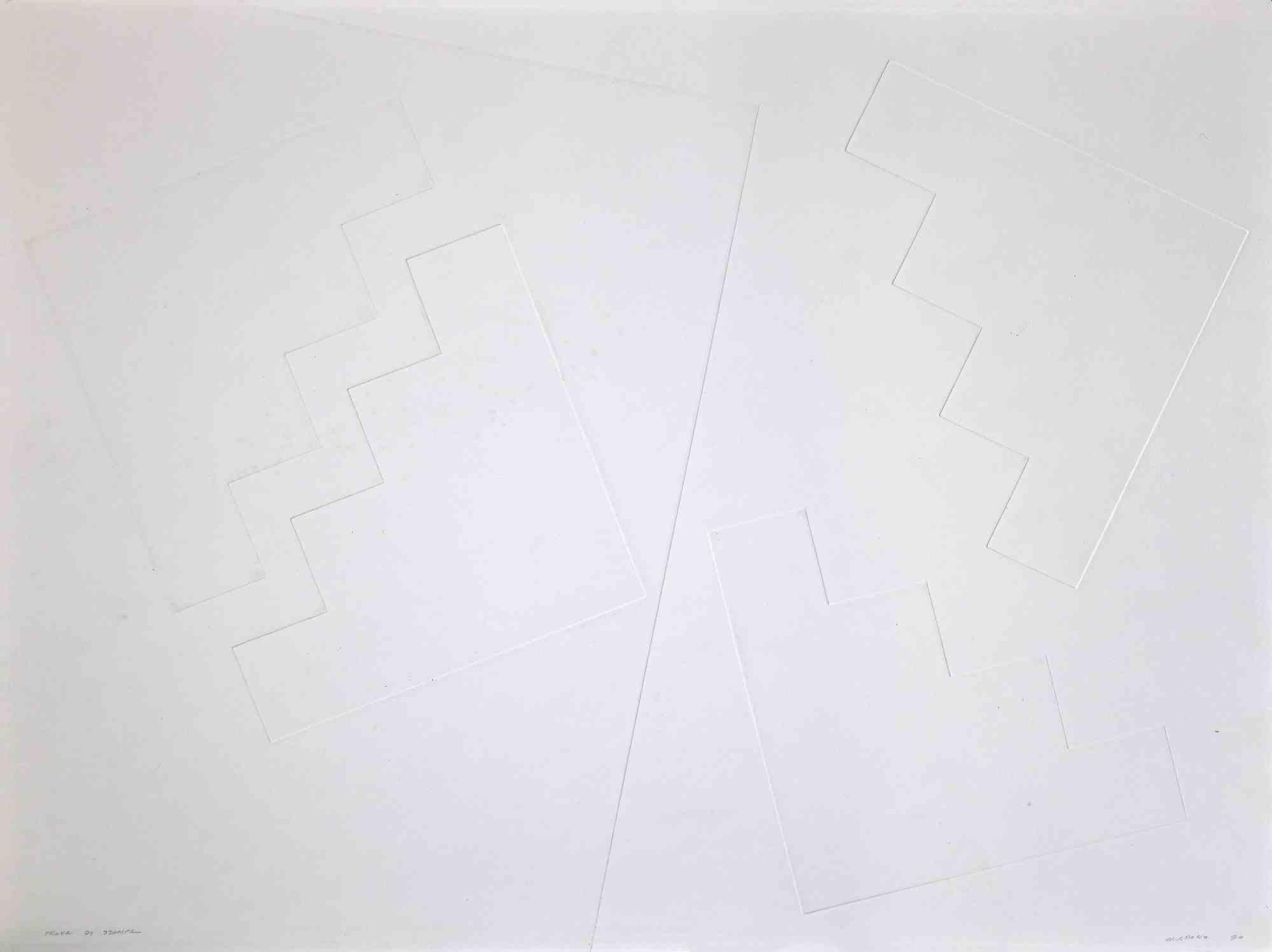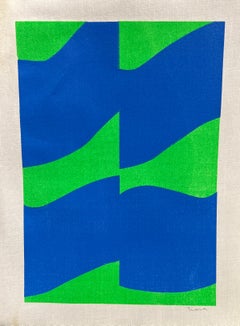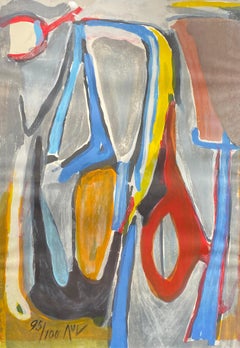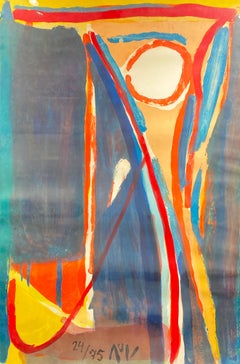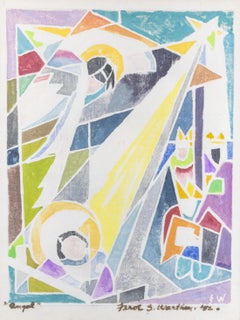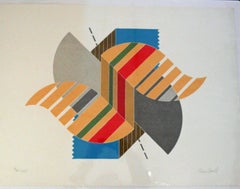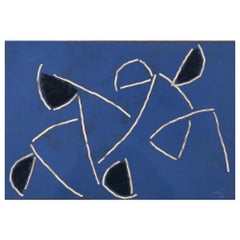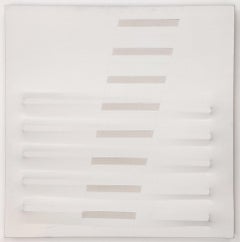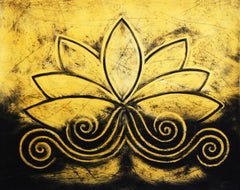Want more images or videos?
Request additional images or videos from the seller
1 of 6
Angelo SavelliLotusc. 1965
c. 1965
$1,500
£1,143.24
€1,306.80
CA$2,110.41
A$2,311.88
CHF 1,216.89
MX$27,592.94
NOK 15,512.21
SEK 14,180.50
DKK 9,761.55
About the Item
Angelo Savelli (1911-1995)
"Lotus" c. 1965
Collage and Lithograph
Signed, Titled and Numbered
Ed. 58/200
Framed Size: approx 26 x 21 inches
Image Size: approx. 23 x 19 inches
October 30th, 1911 Angelo Savelli was born in Pizzo Calabro (Catanzaro). Since his very childhood, Savelli's interest in art grows thanks to his uncle, the self-taught painter Alfonso Barone.
1930 After attending Filangieri Grammar School in Vibo Valentia, Calabria, he is encouraged by his father Giorgio, an apothecary, to develop his artistic potential; Savelli moves to Rome and attends a high school specializing in arts, and later the Academy of Fine Arts. During this period Savelli is a guest of the Minister of the Royal House of Savoy, Lucifero Falcone, a friend of his father's.
1934 He obtains a pilot's licence from the Ministry of War. The licence also entitles him to a student grant.
1935 He wins the "Mattia Preti" award and later the "Balestra" award for an art contest organized by San Luca Academy in Rome.
1936 He receives his diploma from the Academy of Fine Arts. His decorative painting teacher is Ferruccio Ferrazzi, who ecomes his most important point of reference. Savelli decorates with frescoes the Villa Boimond chapel in Sora (Frosinone), and wins a prize at the Regional Exhibition of Calabria.
1937 He leaves for his military service and enters officer school at the 39th Infantry Regiment.
1939 He serves as an officer in the 81st Infantry Regiment in Frosinone.
1940 He begins teaching at the Academy of Fine Arts in Rome, and keeps up an intense artistic activity. He settles in his studio at 49 Via Margutta, a most popular area among artists such as Guttuso, Franchina, Jarema, Fazzini, Severini. He wins a prize at the Regional Exhibition of Lazio.
1941 He is awarded one of the four 2.500 Lire additional prizes by the Third Bergamo Award, and the following year one of the four 5.000 lire additional prizes by the Fourth Bergamo Award. He reads his first book on Yoga philosophy and meditation, which leads him to discover the spiritual path he will follow all his life.
1943 He is redrafted into the army and assigned to the 82nd Infantry regiment "Torino". After the painful experience of World War II, he returns to Rome where he moves in the milieu of Futurism. In the same year he becomes a member of the Art Club, the independent international artistic association whose members include Jarema (a Polish artist Savelli called "the Viking"), Severini, Guzzi, Montanarini and Tamburi, his close friend Fazzini, and later Dorazio, Mafai, Corpora, Perilli, Consagra and Turcato. This group of artists, active in Rome or having ties with Rome in the Twenties and Thirties, is known as "Scuola Romana" or Roman School. Savelli forms with each one bonds of friendship he will cherish all his life. At the same time he meets Alberto Burri, then at the beginning of his artistic career; unlike many others, Savelli is most available and open-minded to younger artists.
1946-1947 First works where white abstract-figurative patches begin to appear. In several Crucifixions, Christ and Mary Magdalene are painted in white. Savelli needs to experience new emotions; by now he finds the Roman School too limiting, whereas Futurism and Prampolini's latest experiments urge him to search for new techniques.
1947 He stays for several months in Venice. He wins the "Colli Euganei" prize at Abano.
1948 Soggiorna per alcuni mesi a Venezia. Riceve il premio "Colli Euganei" ad Abano.
1948 He gets a one-month scholarship in Paris, and will stay there for a year. This experience is critical for him, and launches him into a wider and more international dimension of art. He declares: "I realized I had to free myself from my divine Italian tradition." During this period he works very intensely and produces many ink and water-colour drawings, with tracts beginning to tend towards a gradual stylization.
1949 Back in Rome, he finds it hard to have his new choices accepted by his friends. After the Expressionist tendencies of his Roman years, he returns from Paris with a different view on modern art, one that cannot be understood by his contemporaries in Rome; only Corpora, Turcato and Santommaso are attuned to it. At Caffè Rosati, patronized by the art world, he meets the young Federico Fellini, who spends hours watching and studying the artists and intellectuals. In the same year in Rome Savelli also meets Theodoros Stamos.
1950 First abstract creations with the two pieces "Oltre l'inquieto". He is present at the XXV Biennale di Venezia.
1953 He marries journalist Elisabeth Fischer. By now a well-known and successful artist, he bravely chooses to leave Italy for good. He settles in New York, a tough, vital city, competitive but international. He also leaves his posts as teacher at the Academy of Fine Arts in Rome. ?In New York he soon gets to know the most important artists of the moment; Fritz Glarner, Marcel Duchamp, Hans Richeter. He is held in high esteem by all the great representatives of abstract painting, from Robert Motherwell to Ad Reinhardt and Barnett Newman, who is very fond of him. He frequents the Art Club on 10th St. and the New York School artists, among whom Philip Pavia and Jack Tworkov. The latter lets him have his studio between 10th St. and 4th Av. Just opposite the studio are Franz Kline's and Wilhelm Dekooning's workshops. But even though he has become a member of this top quality artists' circle, he does not want to be identified with one group or one circle, he does not mix with art dealers just to sell his works, he accepts no compromises. He is a man of free spirit and is loved for his humanity and sensitivity, for the poetry and innocence of his personality. In 1953 he also meets artist Will Barnet at Cooper Union University, and they form a bond of true brotherhood.
1954 He creates the work "Oval Skin".
1955 He begins a series of serigraphs and collages at Chelsea Workshop.
1956 He creates "Bianco su bianco", a monochrome serigraph, his first completely white piece.
1957 Savelli's first exhibition (collective) in New York. The same year, personal exhibition at D'Amecourt Gallery, Washington D.C.
1958 With some Art Club friends he meets in a New York bar the great art dealer Leo Castelli, who offers to set up an exhibition. His first personal exhibition at Leo Castelli Gallery on 77th St. marks the beginning of the most important period of his career in the USA. In the same year he also receives the "Battistoni" international prize for industrial design.
1959 Appointed Director of the art school "La Guardia Memorial House", the illustrious American Academy in Harlem. He will act as supervisor for the art classes held by the institute.
1959 He approaches the white colour through relief printings, changes the materials, rejects colours, modifies the shapes of his works, paints in white with a spatula, and later uses strings, plasters, very light and transparent fabrics, veils and tulle, extolling white as the only pure, bright and absolute colour. He works out a monochrome art, distancing himself from the expressive violence of "action painting", realizing works of extreme lightness and formal purity, from a compelling inner need to reach universal simplicity. Critics define his art as a creation of images free from any figurative reference, aspiring to reach the essential nature of things.
1960 Invited to teach at "Art Workshop", Edna Lewis's American school in Positano (Naples). He also takes part in a workshop on printing techniques in Milan. He invents a lithography process for what he calls "relief prints", an elaborate variation of embossing.
1962 G. Holmes Perkins, president of the University of Pennsylvania, and influential architect Louis Kahn, a University alumnus, decide to modernize the school, appointing as teachers important experts of the new generation. Romoaldo Giurgola, an Italian architect living in America, suggests they invite Angelo Savelli and his old Via Margutta friend Piero Dorazio to reorganize the study programme for the Department of Fine Arts - painting, sculpture and graphics. Savelli accepts and moves to Pennsylvania. He supervises all the activities of the students - who consider him a most charismatic figure - giving them practical help in their working choices. He is a great authority on technique, painting and drawing, and his ability as Maestro is well known among young American artists. In a short time the university becomes the best school of arts in the USA. ?During this period Savelli suffers from serious physical disorders that he manages to overcome thanks to his deeper and deeper knowledge of Zen philosophy. By practising yoga exercises and meditation every day, a life-long discipline, he is able to get over extremely painful experiences. ?A deep everlasting friendship begins between Savelli, Kahn and Giurgola. Savelli lives for ten years in Springtown, without giving up his New York studio.
1961 He receives the "Lissone" award.
1962 He creates his first works using rope, and also eleven embossed lithographic white-on-white pieces, presented by Giulio Carlo Argan (Grattacielo, Milan 1962).
1963.Publication of a book with lithographs by Savelli: "Ten Poems by Ten American Poets" (Romero, Rome 1963).
1964 He wins the "Gran Premio della Grafica" award at the XXXIII Biennale di Venezia for his twenty-seven white-on-white reliefs.
1965-1970 He creates his first meditation hall called "Paradise", in his studio at 186 Bowery St., New York.
1966 He teaches at Columbia University, in New York.
1969-70 Completion of projects "Paradise II" at Corcoran Gallery of Art in Washington, and "Dante's Inferno" at Peale Galleries of Pennsylvania, Academy of Fine Arts in Philadelphia.
1971 Completion of "Illumine one", a project displayed in 1972 at his Everson Museum personal exhibition, in Syracuse (NY), catalogue introduction by Louis Kahn.
1973 Installation of the sculpture "Empedocles" at Lincoln Center, Syracuse.
1974 He teaches at Cornell University in Ithaca (NY).
1975 He starts a two-year teaching job as Visiting Artist at Pennsylvania State University and creates the work "Wall to Wall", displayed at an exhibition at the same University. He is also invited to teach at the Academy of Fine Arts in Philadelphia, Pennsylvania.
1976 He creates his first unframed canvases, applied directly on the wall. He paints the series of canvases called "On the Quantity of the Surface".
1977 He creates a series of forty white-on-white prints. He accepts the post of Visiting Professor at the University of Texas, Arlington, where he spends the winter semesters for five years.
1978 He creates the installation "Tree with 84 Tree Trunks", displayed at Max Hutchinson Gallery, New York.
1980 He receives the Guggenheim Fellowship from Guggenheim Museum, New York, which allows him to live in Europe and organize personal exhibitions in Milan, Zurich and Rome.
1981 He creates the sculpture "Aglaophon", displayed at Aubodon Art Center, New York.
1982 His wife Elisabeth dies tragically. The depression of his beloved Betty had heavily conditioned Savelli's artistic life for many years. Her dramatic death comes as a great shock to him, which he will get over only after a long period of complete solitude. He leaves New York and flies to his brother Carmelo's in Italy. A few months later he goes back to the USA without having found peace. In time the love of a few friends gives him a measure of comfort. From his memories the most outstanding is writer and poet Luigi Ballerini. The book "Angelo Savelli, Opera grafica 1932-1981" by Giuseppe Apella is published by Scheiwiller. Savelli receives a gold medal for artistic merit from the town of Pizzo Calabro.
1983 He receives an award by the illustrious American Academy of Arts and Letters.
1984 PAC, the Milan museum of contemporary art, prepares a personal exhibition, organized by Luigi Sansone.
1984 Savelli creates "Glory of a Broken Wing, to Elisabeth Fischer" dedicated to his wife: a meaningful and extraordinary work measuring 1650 centimetres (54,13 feet).
1986 The book "Libro bianco", with prints by Savelli and poems by Lucini, is published by Scheiwiller.
1988 He moves to 257 Water Street at Sea Port, Pier 17, just a few meters from the banks of the East River, where Brooklyn Bridge rises majestically. It will be his last studio. It is a red brick town house, the second oldest building in New York. Savelli loves this place and spends a lot of time at "Paris Cafè", a meeting place for young Wall Street operators by day, and a sort of refuge for the fish market people by night: they all know and love him. RAI Corporation in New York produces a documentary movie on his life, directed by Luigi Ballerini, and buys some works by Savelli, displayed at the RAI Corporation building on the Avenue of Americas in the MGM building in New York. ?In the same year "SELVAGGINA", with prints by Savelli and poems by Luigi Ballerini, is published by Scheiwiller.
1989 He meets Susanna Argenterio at RAI Corporation in New York and develops a fatherly affection for her. Thanks to this fond sentiment he feels alive again after years of detachment from the world. They spend a great deal of time together in New York and Italy, at the Argenterio family home near Brescia
1991 Opening of "Angelo Savelli Contemporary Art Center" in Lamezia Terme, Calabria.
1993 He begins the creation of a room at the "Atelier sul Mare" hotel in Castel di Tusa, Sicily, which he will not be able to finish.
1994 Through an artist friend from Tuscany, Giuseppe Friscia, Savelli meets in New York Patrizio Bertelli and his wife Miuccia Prada, who visit his studio and are captivated by his work. From the meeting stems a collaboration with Prada Foundation. Savelli is attracted by Bertelli's vitality and an understanding is reached between the two. When Bertelli visits him again in his studio and explains his ideas about Savelli's artistic future, Angelo accepts his guidance and relies on his support and the suggested organization.
1994 The President of the Biennale di Venezia, Gian Luigi Rondi, informs Savelli that the Biennale committee, following a proposal by the director, Professor Jean Clair, have invited him to be present with a personal exhibition in the Italian section at the XLVI Biennale. ?At the beginning of December, Savelli has some health problems.
1995 Antonella Soldaini, administrator of Luigi Pecci Museum of Contemporary Arts in Prato, invites Savelli to organize an anthological exhibition, to run from June to September of the same year. ?Although this is a wonderful period in Savelli's life, it is also a exhausting time for him, as the novelties and the many consequent decisions overburden him. He realizes that he cannot continue living alone, and with Susanna Argenterio's help he decides to close his New York studio and settle in Italy for a while. ?March 10th, 1995. Savelli, his work and many of his memories reach Milan. He wants to oversee personally the organization of the two planned exhibitions.?? April 17th, 1995.Just a few weeks after his arrival in Italy, while spending Easter in Arezzo, Angelo feels very ill. During the return journey to the Argenterio family home in Brescia his condition worsens, and he is taken to Sant'Orsola Hospital. He is very weak and can breathe only with the help of an oxygen mask.
27th Apr., 1995. Savelli dies at Boldeniga Castle, in Dello (Brescia), at eighty-three, surrounded by friends, love and affection. By a few weeks only, he will fail to see the two personal exhibitions that had so much appealed to him: the XLVI Biennale di Venezia and the Pecci Museum exhibition in co-operation with "PradaMilanoArte".
- Creator:Angelo Savelli (1911-1995, Italian)
- Creation Year:c. 1965
- Dimensions:Height: 26 in (66.04 cm)Width: 21.5 in (54.61 cm)Depth: 1 in (2.54 cm)
- Medium:
- Movement & Style:
- Period:
- Condition:Very good overall condition. 1/4 inch size fox mark upper left.
- Gallery Location:Missouri, MO
- Reference Number:1stDibs: LU74732919113
About the Seller
5.0
Vetted Professional Seller
Every seller passes strict standards for authenticity and reliability
Established in 1970
1stDibs seller since 2017
156 sales on 1stDibs
Typical response time: Several days
- ShippingRetrieving quote...Shipping from: Missouri, MO
- Return Policy
More From This Seller
View AllTrova/Index, Waves
By Ernest Tino Trova
Located in Missouri, MO
Trova/Index, Waves, 1969
By. Ernest Tino Trova (American, 1927-2009)
Signed in Pencil Lower Right
Unframed: 10.5 x 7.5 inches
With Frame: 15.25 x 11.75 inches
Known for his Falling ...
Category
20th Century American Modern Abstract Prints
Materials
Screen
Price Upon Request
Abstract (Edition 95/100)
By Bram Van Velde
Located in Missouri, MO
Abstract (Edition 95/100)
By Bram Van Velde (1895-1981)
Numbered Lower Left
Signed Lower Center
Unframed: 37" x 24"
Framed: 37.5" x 25.25"
Bram (Abraham Gerardus) van Velde was a Dutch painter known for an intensely colored and geometric semi-representational painting style related to Tachisme*, and Lyrical Abstraction*. He is often seen as member of the School of Paris* but his work resides somewhere between expressionism* and surrealism*, and evolved in the 1960s into an expressive abstract art. His paintings from the 1950s are similar to the contemporary work of Matisse, Picasso and the abstract expressionist Adolph Gottlieb. He was championed by a number of French-speaking writers, including Samuel Beckett and the poet André du...
Category
20th Century Abstract Abstract Prints
Materials
Lithograph
Price Upon Request
Abstract (Edition 24/75)
By Bram Van Velde
Located in Missouri, MO
Abstract (Edition 24/75)
By Bram van Velde (1895-1981)
Signed and Numbered Bottom Center
Without Frame: 37" x 24"
With Frame: 37.75" x 24.75"
Bram (Abraham Gerardus) van Velde was a Dutch painter known for an intensely colored and geometric semi-representational painting style related to Tachisme*, and Lyrical Abstraction*. He is often seen as member of the School of Paris* but his work resides somewhere between expressionism* and surrealism*, and evolved in the 1960s into an expressive abstract art. His paintings from the 1950s are similar to the contemporary work of Matisse, Picasso and the abstract expressionist Adolph Gottlieb. He was championed by a number of French-speaking writers, including Samuel Beckett and the poet André du...
Category
20th Century Abstract Abstract Prints
Materials
Lithograph
Price Upon Request
Angel
Located in Missouri, MO
Angel, 1952
Ferol K. Sibley Warthen (American, 1890-1986)
Color Woodblock Print
6.5 x 5 inches
16 x 13.75 inches with frame
Signed Lower Right
Titled Lower Left
Born 1890, Died 1986...
Category
1950s American Modern Abstract Prints
Materials
Color
Peace
By Heloise Crista
Located in Missouri, MO
Heloise Crista (1926-2018)
Peace
Brass and Copper
approx. 15 x 17 x 10 inches
Heloise Crista, Acclaimed Sculptor and Frank Lloyd Wright Apprentice
FRANK LLOYD WRIGHT FOUNDATION JU...
Category
Mid-20th Century American Modern Abstract Sculptures
Materials
Brass, Copper
Price Upon Request
Abstract (Edition 48/100)
By Bram Van Velde
Located in Missouri, MO
Abstract (Edition 48/100)
By Bram van Velde (1895-1981)
Without Frame: 37" x 24"
With Frame: 37.75" x 24.75"
Signed and Numbered Bottom Left
Bram (Abraham Gerardus) van Velde was a Dutch painter known for an intensely colored and geometric semi-representational painting style related to Tachisme*, and Lyrical Abstraction*. He is often seen as member of the School of Paris* but his work resides somewhere between expressionism* and surrealism*, and evolved in the 1960s into an expressive abstract art. His paintings from the 1950s are similar to the contemporary work of Matisse, Picasso and the abstract expressionist Adolph Gottlieb. He was championed by a number of French-speaking writers, including Samuel Beckett and the poet André du...
Category
20th Century Abstract Abstract Prints
Materials
Lithograph
Price Upon Request
You May Also Like
LOTUS
By Thomas Barrett
Located in Portland, ME
Barrett, Thomas. LOTUS. Screenprint in colors, not dated. Edition of 100. Numbered 89/100, titled and signed and dated in pencil. 22 1/2 x 28 1/2 inches. In excellent condition.
Category
20th Century Abstract Abstract Prints
Materials
Screen
Sans titre
Located in PARIS, FR
signed on bottom
Category
Late 20th Century Abstract Abstract Paintings
Materials
Oil
BIANCO
By Agostino Bonalumi
Located in Aventura, FL
Original shaped canvas and vinyl tempera. Hand-signed and dated on verso by the artist. Canvas is stretched.
Artwork in excellent condition. All reasonable offers will be considered.
Category
1980s Abstract Mixed Media
Materials
Canvas, Vinyl, Tempera
$71,600 Sale Price
20% Off
Lotus II
Located in Miami, FL
The lotus is a sacred flower in many religious traditions and refers to spiritual awakening and purity of heart. This meditative symbol is a metaphor for rebirth and a life unfolding...
Category
2010s Prints and Multiples
Materials
Drypoint, Monoprint
Diamonds
By George Ortman
Located in New York, NY
George Ortman
Diamonds, 2004
Acrylic on board
35 x 16 x 6 inches
Signed recto
Category
Early 2000s Abstract Geometric Abstract Paintings
Materials
Acrylic, Board
Structure - Etching and Embossing by Nicola Carrino - 1970
By Nicola Carrino
Located in Roma, IT
Structure is an abstract etching on paper realized by the artist Nicola Carrino in 1970. The state of preservation is very good.
Hand-signed in pencil on the lower right margin a...
Category
1970s Abstract Abstract Prints
Materials
Etching
$442 Sale Price
35% Off
More Ways To Browse
Vintage Club International
House Of Savoy
Mattia Preti
Sophie Taeuber Arp Print
The Brothers Karamazov
Totem Mario
Tracey Emin Towel
Twombly Poster
Tyler Mitchell
Vera Molnar
Vincent Gordon
Vintage Original Posters Otis Redding
W Hoffman
Walker Art Center Poster
Warhol Art Cash
Warhol Pasadena
Wassily Kandinsky 1911
Yaacov Agam Rainbow
